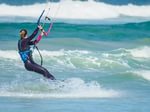It is one the oldest assertions ever made about the sport: if you ride a kite, you can get yourself killed. But how true is that? Is it a preconceived idea or kiteboarding will, sooner or later, injure you?
In 2012, Amit Inbar, an Israeli windsurfer stated that “kiteboarding is ten times more dangerous than windsurfing.”
Both sports were fighting for a spot in the Olympic program, and the discussions between both sides of the barricade were slightly heated up.
But, how accurate was Inbar’s statement? Were people putting their lives at risk by riding a kite in medium-to-high wind conditions?
The truth is that kite accidents are everywhere. They’re in the news, and scary footage featuring horrendous tragedies can be easily found in any popular video-sharing website like YouTube or Vimeo.
We all know the horrible truth. People have been seriously injured or killed while kiteboarding, and that is not good for any sport.
They’ve been slammed against piers and breakwaters, buildings and parking lots, or thrown up in the air like marionettes before free-falling from impossible heights.
In the first decade of the new millennium, kiteboarding developed a negative reputation essentially through terrible pictures and frightening videos of incredible crashes and disastrous line entanglements.

Sports specialists and detractors said that kite lines are like knives in high winds and that kites are bombs ready to explode at any moment.
Kiteboarding was constantly attacked for being a life-threatening sport that also put other people’s lives – mainly surfers, windsurfers, bodyboarders, and beachgoers – in jeopardy.
So, is kiteboarding really dangerous? Are water sports enthusiasts signing a death warrant when they try kitesurfing for the first time? Or are safety issues one of the myths that continue to depict the sport?
Kiteboarding vs. Other Sports
In 2016, Christiaan van Bergen led a study that analyzed the number and the seriousness of injuries windsurfers and kiteboarding suffered in the North Sea over a two-year period.
The research observed windsurfers and kiteboarders enjoying their time in the water in the same weather and environmental conditions, and scrutinized the sports injuries presented at a coastal hospital.
“The injury rates were 5.2 per 1,000 hours of windsurfing and 7.0 per 1,000 hours of kitesurfing,” the study reveals.
“Kitesurfers had a higher injury rate, and required transport by ambulance, inpatient hospital stays and operative treatment more often than windsurfers, even though the severity of the injuries does not differ.”
“Most patients sustained minor injuries, but severe injuries also occurred, including vertebral and tibial plateau fractures. The lower extremities were affected the most, followed by the head and cervical spine, the upper extremities, and the trunk.”
With seven injuries per 1,000 hours of physical activity, kiteboarding appears listed as a relatively safe sport, especially when compared to mainstream sports.

American football has an average of 36 injuries per 1,000 hours; even soccer seems to be more dangerous with 19 injuries per 1,000 hours or sporting activity.
And if you take into consideration that the percentage of sports accidents taking place in the water and on land is identical, then it is fair to say that kitesurfing is, as we know it today, a reasonably safe sport.
Knowledge Reduces Danger
Like with any other physical activity, kiteboarding will never be a risk-free sport. There are many technical, environmental, and personal variables involved in the equation.
Wind is a very serious power source and is constantly shifting. But today, safety is in the riders’ hands. They’re the ones who make kiteboarding a pleasant and secure sport, or a lethal activity.
And more than 90 percent of the risks can be handled by getting to know how the sport works, and what should be done to mitigate accidents.
If you’ve decided to learn to ride a kite, book a few lessons in a certified school. And never go out by yourself without understanding how your wing flies in the wind window.
If you’re desperate to start kiteboarding, get yourself a trainer kite and fly it in an open space area, unhooked from the harness, and in light wind conditions.
Get acquainted with the fundamental rules of kiteboarding and the safety sailing procedures, and respect everyone in and out of the water.





Recent Comments